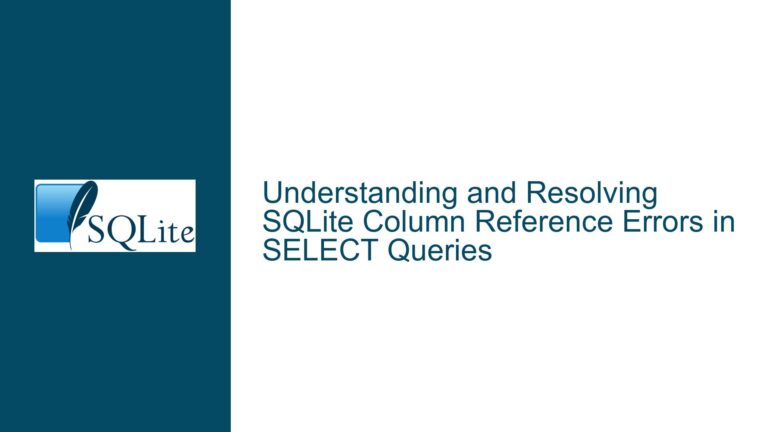Handling Timezone-Aware Datetime Comparisons in SQLite: Formatting Pitfalls and Validation
Understanding SQLite’s Datetime Parsing with Timezone Offsets
Core Challenge: Datetime Comparisons Fail When Timezone Information is Included
The primary issue revolves around datetime values stored as TEXT in SQLite with timezone offsets, causing unexpected results when filtered using datetime() functions. Queries that work with simple YYYY-MM-DD HH:MM:SS formats fail when timezone offsets (e.g., +01:00) are appended. The problem stems from how SQLite interprets datetime strings with non-standard or improperly formatted timezone components. This guide dissects the root causes, validation strategies, and corrective measures to resolve datetime comparison issues in timezone-aware contexts.
Diagnosing Datetime Parsing Errors and Timezone Misalignment
1. Invalid Datetime String Formatting
SQLite’s datetime functions require strict adherence to supported formats. When a timezone offset is included, the format must follow YYYY-MM-DD HH:MM:SS±HH:MM or YYYY-MM-DD HH:MM:SS.sss±HH:MM. Common errors include:
- Extra Colons or Delimiters: Appending a colon between seconds and the timezone (e.g.,
2022-12-28 20:44:00:+01:00instead of2022-12-28 20:44:00+01:00). - Incorrect Offset Syntax: Using
+0100instead of+01:00or omitting the colon in the offset. - Misplaced Timezone Data: Including timezone abbreviations (e.g.,
CET) or non-standard offsets, which SQLite does not natively parse.
2. Silent Parsing Failures in datetime() Conversions
When SQLite encounters an invalid datetime string, the datetime() function returns NULL instead of raising an error. This leads to logical mismatches in queries:
-- Example: Invalid datetime string returns NULL
SELECT datetime('2022-12-28 20:44:00:+01:00'); -- NULL
If the start column contains such values, conditions like datetime(start) > datetime('now') evaluate to NULL > [current time], which is logically false. Consequently, no rows are returned even if valid future dates exist.
3. Timezone Offset Normalization
SQLite normalizes datetime strings with offsets to UTC before comparisons. For example:
SELECT datetime('2022-12-28 20:44:00+01:00'); -- '2022-12-28 19:44:00' (UTC)
If the application expects comparisons in local time, this normalization causes discrepancies. Developers often overlook that datetime arithmetic in SQLite is always UTC-based unless explicitly converted to another timezone using datetime() modifiers (e.g., localtime).
Resolving Datetime Parsing and Comparison Issues
Step 1: Validate Stored Datetime Formats
Identify invalid datetime strings by querying for rows where datetime(start) is NULL:
SELECT start FROM table WHERE datetime(start) IS NULL;
This exposes formatting errors like extra colons, missing offsets, or incorrect delimiters.
Common Fixes:
- Remove Extraneous Characters: Ensure the timezone offset directly follows the seconds component without additional separators. For example, convert
2022-12-28 20:44:00:+01:00to2022-12-28 20:44:00+01:00. - Standardize Offset Syntax: Use
±HH:MMformat consistently. Convert+0100to+01:00.
Step 2: Correct Timezone Handling in Application Code
Modify the data ingestion pipeline to ensure datetime strings comply with SQLite’s requirements. For example, in Kotlin:
fun toMyTimeFormat(date: String): String {
// Extract components from the source string (adjust indices as needed)
val year = date.substring(0..3)
val month = date.substring(4..5)
val day = date.substring(6..7)
val hour = date.substring(8..9)
val minute = date.substring(10..11)
val second = date.substring(12..13)
val tz = date.substring(14).replace(" ", "").chunked(2).joinToString(":")
return "$year-$month-${day}T$hour:$minute:$second$tz"
}
Key Adjustments:
- Avoid inserting colons or spaces between the time and offset.
- Use
Tas the date-time separator if ISO 8601 compatibility is needed (optional for SQLite).
Step 3: Use Explicit Timezone Conversions in Queries
To compare datetimes in a specific timezone, leverage SQLite’s modifiers:
-- Convert stored datetime (with offset) to local time
SELECT datetime(start, 'localtime') AS local_start FROM table;
For UTC-based comparisons:
-- Compare normalized UTC times
SELECT * FROM table WHERE datetime(start) > datetime('now');
Step 4: Indexing and Performance Optimization
Datetime comparisons can be slow on large datasets. Improve performance by:
- Storing Datetimes in UTC: Normalize all datetimes to UTC before insertion to simplify comparisons.
- Creating Indexes on Computed Columns: Use generated columns to store UTC-normalized datetime values and index them:
ALTER TABLE table ADD COLUMN start_utc TEXT GENERATED ALWAYS AS (datetime(start));
CREATE INDEX idx_start_utc ON table(start_utc);
Step 5: Testing and Validation Framework
Implement automated tests to verify datetime parsing and query logic:
- Unit Tests for Datetime Conversion Functions: Ensure application code generates valid SQLite datetime strings.
- Query Validation Scripts: Use SQLite’s command-line shell to test queries with sample data:
sqlite3 test.db <<EOF
CREATE TABLE test (start TEXT);
INSERT INTO test VALUES ('2022-12-28 20:44:00+01:00');
SELECT datetime(start), datetime('now') FROM test;
EOF
- Boundary Condition Testing: Verify edge cases like daylight saving transitions and leap seconds.
Preventing Future Issues: Best Practices
- Adopt ISO 8601 Formats: Use
YYYY-MM-DDTHH:MM:SS±HH:MMfor unambiguous datetime storage. - Centralize Datetime Handling: Implement application-layer utilities to enforce consistent datetime formatting across all database interactions.
- Document Timezone Assumptions: Clearly state whether datetimes are stored in UTC, local time, or with offsets.
- Leverage SQLite Extensions: Consider using extensions like
sqlite3-datefor enhanced timezone support if needed.
By addressing formatting errors, understanding SQLite’s datetime normalization behavior, and implementing rigorous validation, developers can ensure reliable datetime comparisons in timezone-aware applications.






